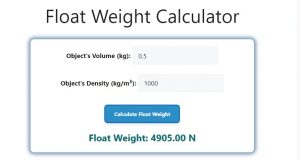About Float Weight Calculator (Formula)
The Float Weight Calculator is an essential tool for engineers, marine scientists, and hobbyists alike, helping to determine the weight of an object that is floating in a fluid. Understanding float weight is crucial in various applications, including shipbuilding, buoy design, and any situation where buoyancy plays a significant role. This article will explain the formula used for calculations, how to effectively use the calculator, and provide answers to common questions regarding float weight.
Formula
The formula for calculating float weight is: Float Weight (FW) = Volume (V) * Density (D) * 9.81. In this formula, Volume refers to the amount of fluid displaced by the object, Density represents the fluid’s density, and 9.81 is the acceleration due to gravity in meters per second squared.
How to Use
Using the Float Weight Calculator is straightforward:
- Determine Volume: Measure or estimate the volume of the object in cubic meters (m³).
- Identify Density: Find the density of the fluid in which the object is floating, typically in kilograms per cubic meter (kg/m³).
- Input Values: Enter the volume and density into the calculator.
- Calculate: Click the “Calculate” button to obtain the float weight.
- Interpret the Result: The output will provide the float weight in newtons (N), representing the weight of the displaced fluid due to the object.
Example
Let’s calculate the float weight of an object with a volume of 0.5 m³ submerged in water, which has a density of 1000 kg/m³.
- Volume (V): 0.5 m³
- Density (D): 1000 kg/m³ (density of water)
- Formula Application:
Float Weight (FW) = Volume (V) * Density (D) * 9.81
FW = 0.5 m³ * 1000 kg/m³ * 9.81
FW = 0.5 * 1000 * 9.81
FW = 4905 N
In this example, the float weight of the object is 4905 newtons.

FAQs
- What is float weight?
Float weight is the weight of the fluid displaced by an object floating in a liquid, which determines the buoyancy of the object. - Why is the density of the fluid important?
The density of the fluid affects the amount of buoyant force acting on the object. Denser fluids provide more buoyancy. - What units are used in this calculation?
Volume is measured in cubic meters (m³), density in kilograms per cubic meter (kg/m³), and float weight in newtons (N). - Can this calculator be used for any fluid?
Yes, the calculator can be used for any fluid, provided you have the correct density for that fluid. - What if I don’t know the volume?
You can calculate the volume based on the shape of the object, using geometry or displacement methods. - What happens if the object is partially submerged?
You need to calculate the volume of only the submerged part to determine the float weight accurately. - Can I use this calculator for gases?
While the concept applies, gases are less common in buoyancy calculations; however, the principles remain similar. - How does temperature affect fluid density?
Fluid density can change with temperature; typically, density decreases as temperature increases. - Is this calculation applicable in shipbuilding?
Yes, understanding float weight is crucial for designing ships and boats to ensure they remain buoyant and stable. - Can I calculate float weight for irregularly shaped objects?
Yes, use the water displacement method to find the volume for irregularly shaped objects. - What is the significance of the acceleration due to gravity?
The value of 9.81 m/s² represents the acceleration due to Earth’s gravity, affecting how weight is calculated. - How do I find the density of a specific fluid?
Density can typically be found in fluid property tables or calculated using mass divided by volume. - Does float weight change in different fluids?
Yes, float weight will vary depending on the fluid’s density; objects will weigh more in denser fluids. - What is buoyancy?
Buoyancy is the upward force exerted by a fluid that opposes the weight of an object submerged in it. - Can this calculator help with underwater construction?
Yes, knowing float weight is crucial for ensuring that structures remain stable and buoyant in water. - What if my object sinks?
If an object sinks, its float weight is less than its weight, indicating that it is denser than the fluid. - What is the difference between weight and float weight?
Weight refers to the gravitational force on an object, while float weight refers to the upward buoyant force acting on the object when submerged. - Can this calculator be used for industrial applications?
Yes, it’s applicable in industries involving fluids, such as shipping, oil and gas, and chemical processing. - How accurate do my measurements need to be?
The accuracy of measurements can vary based on the application; precision is more critical in scientific experiments than in general use. - What happens to float weight in a vacuum?
In a vacuum, buoyancy does not exist, and the concept of float weight becomes irrelevant.
Conclusion
The Float Weight Calculator is a valuable tool for determining the weight of an object based on the volume of fluid it displaces. This calculation is vital in various fields, including engineering, marine science, and environmental studies. By understanding the relationship between volume, density, and float weight, users can make informed decisions regarding buoyancy and stability in fluid environments. With easy-to-use features, anyone can accurately calculate float weight and apply these principles to their specific needs.